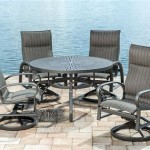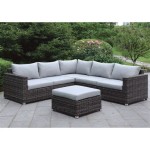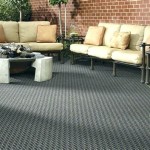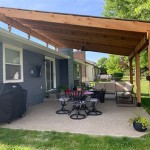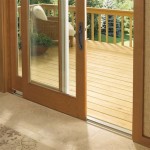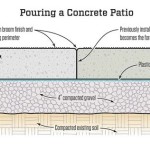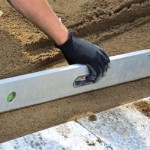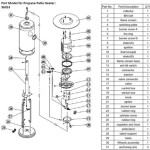Patio Dining Table With Fire: Enhancing Outdoor Living
A patio dining table with fire is a sophisticated and functional addition to any outdoor living space. It seamlessly blends the practicality of a dining surface with the ambiance and warmth of a fire pit, creating a focal point for relaxation and entertainment. Such tables offer an extended season of outdoor enjoyment, allowing individuals to gather comfortably even on cooler evenings.
The integration of a fire feature into a dining table is not merely an aesthetic choice; it is a deliberate effort to enhance the overall sensory experience. The gentle glow of the flames, the subtle crackling sound, and the radiating heat combine to foster a convivial atmosphere, conducive to conversation and connection. This type of furniture is increasingly popular among homeowners seeking to maximize the usability and appeal of their patios, decks, and gardens.
Choosing the right patio dining table with fire requires careful consideration of several factors, including size, materials, fuel type, safety features, and design aesthetics. A thorough understanding of these aspects will ensure that the selected table not only meets the functional needs of the space but also complements the existing outdoor décor and adheres to safety standards.
Key Considerations When Choosing a Patio Dining Table With Fire
Selecting the right patio dining table with fire involves several key elements. Evaluating the following aspects ensures the chosen table meets desired needs and aesthetic preferences.
Size and Shape:
The dimensions of the patio dining table with fire should be proportionate to the available space and the anticipated number of users. A table that is too large can overwhelm a small patio, while a table that is too small may not adequately accommodate a larger gathering. The shape of the table, whether round, square, rectangular, or oval, also influences its suitability for different space configurations and social interactions. Round tables, for instance, promote a more intimate and inclusive atmosphere, while rectangular tables are often better suited for formal dining arrangements.Furthermore, consider the height of the table in relation to the seating. Ideally, the table height should allow for comfortable dining and conversation without requiring individuals to strain or slouch. Standard dining table heights typically range from 28 to 30 inches, but variations may exist depending on the specific design and intended use. Carefully measuring the available space and assessing the typical number of diners will help determine the ideal size and shape of the patio dining table with fire.
Materials and Durability:
Patio furniture is exposed to the elements, so material selection is crucial for longevity and aesthetic preservation. Common materials for patio dining tables with fire include aluminum, stainless steel, wood (such as teak or cedar), and composite materials. Each material offers a distinct combination of durability, weather resistance, and aesthetic appeal.Aluminum and stainless steel are known for their resistance to rust and corrosion, making them ideal for outdoor environments. Wood, particularly teak and cedar, offers a natural and warm aesthetic but requires regular maintenance to prevent weathering and decay. Composite materials are often designed to mimic the appearance of wood while offering enhanced durability and resistance to moisture and insects. The fire pit component itself typically utilizes stainless steel or other heat-resistant materials to withstand the high temperatures produced by the flames.
When selecting a patio dining table with fire, it is essential to consider the climate and environmental conditions to which the table will be exposed. In areas with heavy rainfall or extreme temperatures, materials with superior weather resistance are highly recommended. Additionally, consider the ease of maintenance associated with each material. Some materials require regular cleaning and sealing to maintain their appearance and integrity, while others are relatively low-maintenance.
Fuel Type and Heat Output:
The type of fuel used to power the fire pit significantly impacts its performance, convenience, and environmental impact. Common fuel options for patio dining tables with fire include propane, natural gas, and wood. Each fuel type has its own advantages and disadvantages in terms of cost, availability, and heat output.Propane-fueled fire pits are portable and easy to use, requiring only a refillable propane tank. They offer a moderate heat output and are relatively clean-burning. Natural gas-fueled fire pits require a permanent connection to a natural gas line, which may limit their portability but provides a consistent and reliable fuel source. Natural gas is often less expensive than propane and typically produces a higher heat output. Wood-burning fire pits offer the traditional ambiance and aroma of a real wood fire but require more effort to maintain and may produce more smoke and ash.
The heat output of the fire pit is measured in British Thermal Units (BTUs). A higher BTU rating indicates a greater amount of heat produced. The appropriate BTU rating for a patio dining table with fire depends on the size of the table, the desired level of warmth, and the climate. In colder climates, a higher BTU rating may be necessary to provide adequate heat. Consider the available fuel sources and the desired level of heat output when selecting a patio dining table with fire.
Safety Features of Patio Dining Tables With Fire
Safety is paramount when operating any fire feature, especially one integrated into a dining table. Manufacturers incorporate various safety features to minimize the risk of accidents and injuries.
Flame Control Mechanisms:
Most patio dining tables with fire incorporate flame control mechanisms, such as adjustable valves or electronic ignition systems, to regulate the size and intensity of the flames. These mechanisms allow users to customize the heat output based on their preferences and the ambient temperature. Adjustable valves provide manual control over the gas flow, while electronic ignition systems offer push-button or remote-controlled operation. Some advanced systems also include safety shut-off features that automatically extinguish the flames if the table is tipped over or if the gas supply is interrupted.Regularly inspect the flame control mechanisms for any signs of wear or damage. Ensure that the valves are functioning properly and that the ignition system is reliable. Follow the manufacturer's instructions for operating and maintaining the flame control mechanisms to ensure safe and efficient operation.
Protective Barriers and Screens:
Many patio dining tables with fire include protective barriers or screens to prevent accidental contact with the flames. These barriers may consist of mesh screens, glass panels, or decorative metalwork that surrounds the fire pit opening. The purpose of these barriers is to create a physical separation between the flames and the surrounding area, reducing the risk of burns or clothing igniting.Ensure that the protective barriers are securely attached to the table and that they are free from any damage or obstructions. Regularly clean the barriers to remove any debris or buildup that could impede visibility or airflow. Never attempt to bypass or remove the protective barriers, as this could significantly increase the risk of accidents.
Ventilation and Airflow:
Proper ventilation and airflow are essential for the safe operation of a patio dining table with fire. Adequate ventilation ensures that the fire receives sufficient oxygen to burn efficiently and prevents the buildup of carbon monoxide, a potentially dangerous gas. Most fire pits are designed with ventilation openings or vents that allow air to circulate freely around the flames.Ensure that the ventilation openings are not obstructed by furniture, plants, or other objects. Regularly inspect the ventilation openings for any signs of blockage or debris. Never operate a patio dining table with fire in an enclosed or poorly ventilated space, as this could lead to a buildup of carbon monoxide. A carbon monoxide detector is recommended for use in areas where fuel-burning appliances are used.
Design and Aesthetic Considerations
Beyond functionality and safety, the design and aesthetic appeal of a patio dining table with fire are crucial for creating a visually appealing and cohesive outdoor living space.
Style and Finish:
Patio dining tables with fire are available in a wide range of styles and finishes to complement various outdoor décor themes. From modern and minimalist designs to rustic and traditional styles, there is a table to suit every taste and preference. Consider the existing style of your patio or garden and choose a table that harmonizes with the overall aesthetic.The finish of the table also contributes to its visual appeal and durability. Powder-coated finishes are popular for aluminum and steel frames, as they provide a durable and weather-resistant coating. Wood finishes may range from natural stains to painted surfaces, depending on the type of wood and the desired aesthetic. Choose a finish that complements the material of the table and that is resistant to fading, chipping, and peeling.
Tabletop Materials and Design:
The tabletop material and design are important considerations, as they directly impact the functionality and appearance of the table. Common tabletop materials include glass, stone, wood, and metal. Glass tabletops offer a sleek and modern look, while stone tabletops provide a more natural and rustic feel. Wood tabletops offer warmth and character, while metal tabletops are durable and easy to clean.The design of the tabletop may include features such as inlays, patterns, or decorative edges. Consider the functionality of the tabletop when making your selection. Glass tabletops, for instance, may be prone to scratches, while wood tabletops may require regular sealing to prevent water damage. Choose a tabletop material and design that complements the overall style of the table and that meets your specific needs and preferences.
Integration with Outdoor Décor:
A patio dining table with fire should seamlessly integrate with the surrounding outdoor décor to create a cohesive and inviting space. Consider the colors, textures, and materials of the existing furniture, plants, and accessories and choose a table that complements these elements. Add outdoor rugs, cushions, and throw pillows to enhance the comfort and visual appeal of the space.Landscaping can also play a crucial role in integrating the patio dining table with fire into the outdoor environment. Plant flowers, shrubs, and trees around the patio to create a natural and inviting setting. Use outdoor lighting to highlight the table and surrounding features, creating a warm and inviting ambiance. Thoughtful integration with outdoor décor will transform the patio dining table with fire into a focal point of your outdoor living space.
Agio Oakland 7 Piece Fire Outdoor Dining Set Costco

Stratford Outdoor Fire Pit Dining Set Furniture Firepits Clover Home Leisure

Outdoor Dining Table Meets Fire And Water Pond Trade Magazine
Sunvilla Sarasota 7 Piece Fire Outdoor Patio Dining Set Costco

Hanover Traditions 7 Piece Aluminum Outdoor Bar Height Dining Set With Red Cushions 30 000 Btu Fire Pit Table Trad7pcfpbr The Home

Kenwood Li Dining Height Fire Pit Table Northfield Fireplace Grill

Agio Anderson 7 Piece Fire Outdoor Dining Set

Fire Pit 8 Person Patio Dining Sets At Lowes Com

Modern Style Luxury Outdoor Patio Furniture Gas Fire Pit Table Bowl

Kenwood Dining Gas Fire Table By Outdoor Greatroom Company Best Hearth Patio

